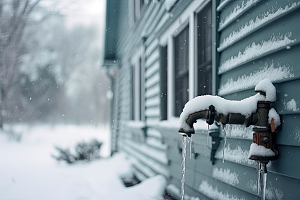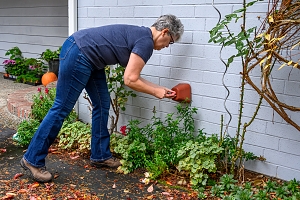Preparing your home for winter is crucial as the season can bring about a myriad of challenges both indoors and outdoors. While certain issues may be inevitable, depending on the severity of the winter, there are numerous proactive measures you can implement to ensure your home is well-equipped and winterized to withstand the harsh conditions.
Why Winterize Your Home?
 Winter brings with it a host of challenges that extend beyond mere inconvenience, reaching into the very core of your home’s well-being. The bone-chilling temperatures and freezing conditions synonymous with winter can wreak havoc on multiple fronts, making it imperative to safeguard your home against potential risks.
Winter brings with it a host of challenges that extend beyond mere inconvenience, reaching into the very core of your home’s well-being. The bone-chilling temperatures and freezing conditions synonymous with winter can wreak havoc on multiple fronts, making it imperative to safeguard your home against potential risks.
Threats to Infrastructure
The structural integrity of your home is vulnerable to the harsh elements of winter. Repeated freeze-thaw cycles can compromise building materials, leading to cracks in foundations, walls, and other critical components. By having professionals winterize your home, you create a robust defense mechanism that shields against these structural threats, ensuring the longevity and stability of your property.
Impact on Heating Systems
The relentless cold of winter places a considerable burden on your heating system, which may have been dormant for an extended period. Without proper preparation, this prolonged inactivity can result in a multitude of issues, including carbon monoxide leaks, worn-out filters, and malfunctioning components.
Through professional inspections and preventive measures, you not only enhance the efficiency of your heating system but also mitigate the risk of costly repairs or, worse, a system failure during the peak of winter.
Landscaping at Risk
Be wary of exterior features on your lawn during a winter storm. Landscaping features, carefully nurtured during milder seasons, face the danger of being adversely affected by freezing temperatures, ice accumulation, and snow loads.
Taking proactive steps to winterize your landscaping not only preserves the aesthetic appeal of your outdoor space but also prevents potential damage to trees, shrubs, and other elements of your property’s natural environment.
Unpredictable Winter Weather Patterns
Winter weather is notoriously unpredictable, with rapid fluctuations and unexpected storms. This unpredictability heightens the importance of proactive preparation. By taking steps to winterize your home, you create a comprehensive defense against the uncertainties of the season, reducing the likelihood of unforeseen inconveniences and the associated costs of emergency repairs.
Financial Savings through Proactive Measures
Beyond the immediate benefits of protection, winterizing your home translates into significant financial savings. The upfront investment in preventive measures pays dividends by averting potential repair expenses caused by winter-related damage. Moreover, an efficiently winterized home operates with greater energy efficiency, leading to reduced heating costs and long-term savings on utility bills.
The decision to winterize your home is a strategic investment in its well-being, resilience, and overall peace of mind. By acknowledging and addressing the multifaceted risks posed by winter weather, you not only protect your property but also pave the way for a comfortable and cost-effective living environment throughout the colder months.
Tips for Winterizing Your Home
 By following a few of these simple steps, you can confront the winter months confidently, potentially preventing major problems from arising:
By following a few of these simple steps, you can confront the winter months confidently, potentially preventing major problems from arising:
HVAC System Inspection: Engage the services of an HVAC professional to inspect your heating system. After months of dormancy, the system may exhibit issues such as carbon monoxide leaks, worn filters, gas piping problems, and motor or fan malfunctions. Ensuring these components are in top condition enhances heating efficiency and can lead to cost savings.
Tree Trimming: Examine your property for overhanging tree branches that could potentially damage your roof, windows, driveway, or other structures during ice storms. Prune or cut back branches that pose a risk to prevent extensive property damage.
Ceiling Fan Reversal: Many are unaware of the reverse function on ceiling fans. Reversing the fan blade direction pushes warm air down, efficiently circulating it throughout the room and addressing cool spots that may not be reached by vents.
Air Leak Inspection: Detect and seal cold drafts around windows, doors, and other potential leak points. Unaddressed leaks not only lead to discomfort but also force your heating system to work harder to maintain a stable temperature.
Protect Hose Spigots: Disconnect garden hoses, store them in a sheltered space, and drain and dry spigots. Use spigot covers to insulate them, preventing freezing and potential damage.
Check Detectors: Ensure your smoke and carbon monoxide detectors are functioning properly, as winter increases the risk of fires due to the use of space heaters, wood furnaces, and fireplaces.
Emergency Kit Preparation: As winter storms may lead to power outages, create an emergency kit with essential supplies like bottled water, canned food, blankets, batteries, flashlights, matches, and a backup power supply.
These steps provide a foundation for winterizing your home, but it’s important to tailor them to your unique living situation.
Get In Touch with Northern Virginia’s Home Winterizing Professionals
Stay proactive, exercise common sense, and consider seeking additional guidance, such as contacting Dirt Connections for more personalized information. They are Northern Virginia’s home winterizing experts. Reach out to us today to learn more about how to proactive winterizing services we offer.








































